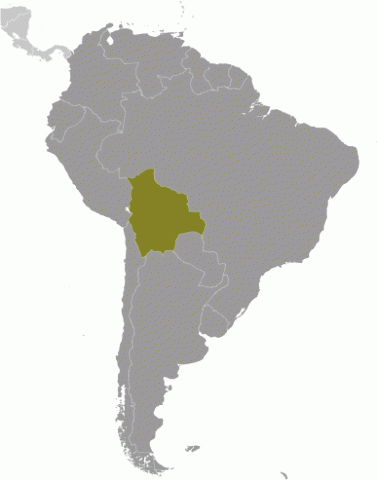Child Labor and Forced Labor Reports
Bolivia


Minimal Advancement
In 2024, Bolivia made minimal advancement in efforts to eliminate the worst forms of child labor. The government launched the Information System for Girls, Boys, and Adolescents, a new system to register and analyze data on the rights and well-being of children and adolescents, aiming to shape and coordinate public policies. The non-governmental organization Educo also trained 2,727 people on trafficking prevention and provided 5,639 children with educational materials, supported by the government's Trafficking in Persons Council. However, despite these efforts, Bolivia's laws do not meet international standards on the prohibition against child trafficking because they require the use of threats, force, or coercion be proven for a crime of child trafficking to have occurred. Bolivian law also does not set a minimum age for participation in apprenticeships. In addition, the lack of funding and short tenure of some police officers, prosecutors, and judges disrupts trafficking in persons investigations.
| Children | Age | Percent of Population |
|---|---|---|
| Working | 5 to 14 | 8.3% (162,834) |
| Boys | 8.2% | |
| Girls | 8.4% | |
| Urban | 2.1% | |
| Rural | 20.8% | |
| Hazardous Work by Children | 15 to 17 | 2.4% (16,085) |
| Boys | 3.2% | |
| Girls | 1.5% | |
| Urban | 2.1% | |
| Rural | 3.4% | |
| Attending School | 5 to 14 | 98.5% |
| Combining Work and School | 7 to 14 | 7.7% |
| Sector/Industry | Percent of Population |
|---|---|
| Agriculture | 73.2% |
| Industry | 5.2% |
| Services | 21.6% |
| Sector/Industry | Activity |
|---|---|
| Agriculture | Harvesting Brazil nuts/chestnuts,† sugarcane,† and coca (stimulant plant); planting and harvesting corn; and raising cattle. |
| Industry | Mining† of gold, silver, tin, lead, and zinc; construction, including heavy lifting and shoveling; and production of bricks.† |
| Services | Street vending, shoe shining, assisting transportation operators, working in small stores, domestric work, and cleaning cemeteries (grave sites). |
| Categorical Worst Forms of Child Labor‡ | Forced labor in domestic work, mining, ranching, in the production and harvesting of Brazil nuts and sugarcane, and begging. Commercial sexual exploitation, including the production of child pornography, sometimes as a result of human trafficking. Use in illicit activities, including robbery and producing, transporting, or sale of drugs. |
† Determined by national law or regulation as hazardous and, as such, relevant to Article 3(d) of ILO C. 182.
‡ Child labor understood as the worst forms of child labor per se under Article 3(a)–(c) of ILO C. 182.
Children at Higher Risk
In 2024, fires in Bolivia led to widespread displacement, forcing many people to flee their homes for temporary shelters or neighboring regions. This mass displacement has heightened the vulnerability of affected populations to various forms of exploitation, including trafficking in persons, sexual exploitation, and forced labor in neighboring countries. Native communities, Venezuelan children, and children living in rural communities experience increased vulnerabilities to child labor exploitation. The number of Venezuelans traveling through Bolivia has increased, and some Venezuelan girls are exploited in sex trafficking. In rural gold mining areas, girls are exploited in sex trafficking and prevented from leaving by private security in brothels, and research indicates that children are at risk of labor trafficking in mines if their families are in debt bondage.
Barriers to Education Access
Attendance rates for secondary education remain low in rural areas. Additionally, the lack of teachers, schools, and textbooks in rural areas, especially in native communities, create barriers to education. Venezuelan children also struggle to obtain the proper paperwork to enroll in the Bolivian public school system, and some of these children do not receive school credit and are prevented from receiving diplomas. Over two million children in Bolivia live in areas at high risk of flooding, while an additional 600,000 live in areas at risk of droughts, disrupting their access to education and increasing their vulnerability to child labor.
| Standard | Age | Meets International Standards | Legislation |
|---|---|---|---|
| Minimum Age for Work | 14 | ✓ | Articles 8 and 58 of the General Labor Law; Article 129 of the Child and Adolescent Code; Sentence 0025/2017 of the Plurinational Constitutional Tribunal; Article 3 of Law No. 1139 |
| Minimum Age for Hazardous Work | 18 | ✓ | Articles 58 and 59 of the General Labor Law; Articles 5 and 136 of the Child and Adolescent Code |
| Identification of Hazardous Occupations or Activities Prohibited for Children | ✓ | Article 136 of the Child and Adolescent Code | |
| Prohibition of Slavery, Debt Bondage, and Forced Labor | ✓ | Articles 15, 46, and 61 of the Constitution; Article 291 of the Penal Code; Articles 6 and 34 of the Comprehensive Law against Human Trafficking and Smuggling | |
| Prohibition of Child Trafficking | ✗ | Article 15 of the Constitution; Articles 6, 34, and 35 of the Comprehensive Law against Human Trafficking and Smuggling | |
| Prohibition of Commercial Sexual Exploitation of Children | ✓ | Articles 34 and 35 of the Comprehensive Law against Human Trafficking and Smuggling; Articles 281 bis, 321, 321 bis, and 323 bis of the Penal Code | |
| Prohibition of Using Children in Illicit Activities | ✓ | Articles 47, 48, and 56 of the Law on Coca and Controlled Substances | |
| Minimum Age for Voluntary State Military Recruitment | 16* | ✓ | Article 2 of the General Directive of Pre-Military Recruitment; Articles 2 and 7 of the Law of National Military Service |
| Prohibition of Compulsory Recruitment of Children by (State) Military | ✗ | Articles 108 and 249 of the Constitution; Article 1 of Supreme Decree No. 1875; Article 1 of Supreme Decree No. 21479 | |
| Prohibition of Military Recruitment by Non-state Armed Groups | ✗ | ||
| Compulsory Education Age | 17‡ | ✓ | Article 81 of the Constitution; Articles 1, 8, 9, and 11–14 of the Avelino Siñani-Elizardo Pérez Education Law |
| Free Public Education | ✓ | Articles 17 and 81 of the Constitution; Article 1 of the Avelino Siñani-Elizardo Pérez Education Law; Article 115 of the Child and Adolescent Code |
* The minimum age for combat is 18 per Article 36 of the Law of National Military Service.
‡ Age calculated based on available information.
As the minimum age for work is lower than the compulsory education age, children may be encouraged to leave school before the completion of compulsory education. Furthermore, although Bolivian law specifies that education is compulsory through secondary school, it does not specify a start or end age. Bolivian law requires employers to allow apprentices time to attend school. However, it does not set a minimum age of at least 14 for participation in apprenticeships. In addition, prohibitions against child trafficking are insufficient because they require that the use of threats, force, or coercion be proven in order for a crime to have taken place. Articles 108 and 249 of the Constitution require Bolivian males to perform compulsory military service in accordance with national law. Article 1 of Supreme Decree No. 1875, passed in 2014, lowered the minimum age at which compulsory military service may begin, from age 18, as previously established, to age 17, which does not comply with international standards.
| Organization/Agency | Role & Activities |
|---|
| Ministry of Labor: Enforces child labor laws by conducting inspections and ensuring that children and adolescents are only working in permitted activities. Prevents forced and dangerous labor through the office Area for the Progressive Eradication of Child Labor (Área de Erradicación Progresiva del Trabajo Infantil) in coordination with the Departmental and Regional Labor Offices. Has Mobile Offices of labor inspectors and legal advisors, focused on rural and remote areas, to detect child labor and hold rights-restitution hearings with labor inspectors, employers, adolescents, and their guardians. However, a lack of inspectors and logistical barriers, such as transportation issues to access the mining sector and the Amazon region, hinder the Ministry of Labor's work. |
| Prosecutor's Office: Enforces criminal laws related to the worst forms of child labor at the departmental level, in coordination with the Attorney General's Office. Coordinates with the Defenders of Children and Adolescents (Defensorías de la Niñez y Adolescencia) in cases in which rights violations related to criminal acts are found involving children or adolescents. Together with the municipal Child Advocate Office, provides legal support and lawyers to child labor victims. The Attorney General's Office oversees investigations and prosecutions at the national level, while regional prosecutors, in collaboration with the Bolivian National Police, pursue cases of human trafficking and maintain a database of these cases. |
| Overview of Enforcement Efforts | 2024 |
|---|---|
| Has a Labor Inspectorate | Yes |
| Able to Assess Civil Penalties | Yes |
| Routinely Conducted Worksite Inspections | Yes |
| Unannounced Inspections Permitted | Yes |
| Has a Complaint Mechanism | Yes |
| Imposed Penalties for Child Labor Violations | N/A |
| Conducted Criminal Investigations for Worst Forms of Child Labor Crimes | Unknown |
| Imposed Penalties for Worst Forms of Child Labor Crimes | Unknown |
In 2024, 117 labor inspectors conducted 2,103 worksite inspections, finding 0 child labor violations. It is unknown whether investigations into suspected cases of the worst forms of child labor were conducted, prosecutions were initiated, or perpetrators were convicted.
| Coordinating Body | Role & Activities |
|---|
| Sectoral and Intersectoral Coordination Council for Child and Adolescent Issues: Coordinates activities to ensure child and adolescent rights, including through the Sub-Council on Child Labor. In 2024, organized the implementation of the Information System for Girls, Boys and Adolescents (SINNA). SINNA will allow for the digital registration and analysis of data on the rights and well-being of children and adolescents, with the aim of shaping and coordinating public policies. |
| Policy | Description & Activities |
|---|
| Plurinational Policy Against Trafficking in Persons, Smuggling of Migrants and Related Crimes (2021–2025): Developed with support from the International Organization for Migration, the UN Office of Drugs and Crime, and civil society, and aims to educate the population about human trafficking and smuggling, reintegrate survivors, train law enforcement officials, provide prompt and effective justice, promote mechanisms for international coordination, and build an institutional environment able to address human trafficking and smuggling. |
| Economic and Social Development Plan (2021–2025): Government program that aims to improve the quality of the education and healthcare systems, with a special emphasis on reducing child labor. However, the impact of this program on child labor is unclear, as the government has not published additional information. |
| Program | Description & Activities |
|---|
| Juancito Pinto Subsidy Program:‡ Ministry of Education program that provides $29 annually to over 2.3 million primary, secondary, and special education students to encourage school attendance and reduce dropout rates. In addition, 74 percent of students receive breakfast at school. |
| Bolivian Foreign Trade Institute's Triple Seal Initiative: Public-private partnership between the Department of Santa Cruz's Ministry of Labor and the Bolivian Institute of Standardization and Quality to develop a voluntary certification program that recognizes companies that comply with Bolivian law and ILO conventions on child labor and forced labor issues. Implemented in large producers who represent 50 percent of the sector. The initiative, known as “Hagamos Equipo,” has received support from local governments, private companies, and UNICEF. In 2024, the Triple Seal certification system remained in use. |
‡ Program is funded by the Government of Bolivia.
| Area | Suggested Action |
|---|---|
| Legal Framework | Raise the minimum age for work from age 14 to age 17 to align with the compulsory education age. |
| Remove the requirement of the use of threats, force, or coercion to be established for the crime of child trafficking to have occurred. | |
| Prohibit children under the age of 14 from participating in apprenticeships. | |
| Establish age 18 as the minimum age for compulsory recruitment by the state military, and criminally prohibit the recruitment of children under age 18 into non-state armed groups. | |
| Enforcement | Publish information on child labor law enforcement, including labor inspectorate funding, and on criminal law enforcement, numbers on investigations conducted, prosecutions initiated, convictions achieved, and sentences imposed for child labor crimes. |
| Employ at least 452 labor inspectors to ensure adequate coverage of the labor force of approximately 6.8 million people. | |
| Provide sufficient funding to increase the Ministry of Labor's capacity to adequately enforce child labor laws, including in remote regions. | |
| Maintain systematized records or a consolidated database on the number of violations found related to child labor and establish a digital tracking system for civil worst forms of child labor. | |
| Ensure that the Ministry of Labor's mobile inspection units have sufficient resources to serve rural areas, so that complaints of potential child labor violations can be made without traveling to offices. | |
| Address issues of high rotation among police, prosecutors, and judges, as well as the existing judicial case backlog, to ensure adequate prosecution of the worst forms of child labor crimes. | |
| Direct sufficient resources to rural areas to address trafficking in persons crimes. | |
| Government Policies | Establish and implement a new national policy or national action plan to address child labor, including its worst forms. |
| Publish information about activities undertaken by the Economic and Social Development Plan 2021–2025 during the reporting period. | |
| Social Programs | Increase availability of schools, teachers, and supplies to rural areas to increase participation in secondary education, and ensure that all children can enroll in school and become eligible to receive academic credit and diplomas. |
| Publish information on activities undertaken by the Juancinto Pinto Subsidy Program and the Bolivian Foreign Trade Institute Triple Seal Initiative during the reporting period. | |
| Establish programs for children displaced by natural disasters to support their continued access to education. | |
| Implement programs to address the commercial sexual exploitation of children. |















